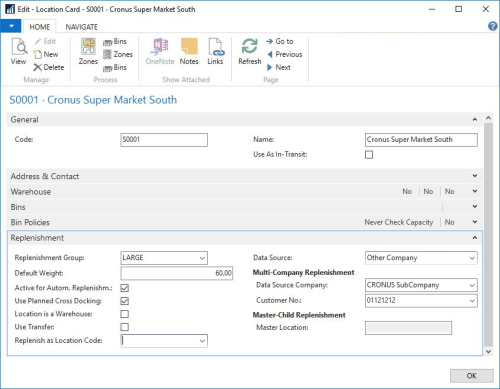To enable a store for Automatic Replenishment you must activate the corresponding location. For each store record, at least one location is defined for the selling of goods.
The Replenishment setup is defined on the Location Card page (Departments - LS Retail - Replenishment - Administration).

| Field | Description |
|---|---|
| Active for Autom. Replenishment | You must select this field for the location or store to be considered in Automatic Replenishment. |
| Use Planned Cross Docking | Select this field to show this location in the Location list on the Cross Dock and Buyer’s Push Matrix pages. |
| Location is a Warehouse | Select this field only if the location record is used for a warehouse. Do not select this field if the location record is used for a store. |
| Replenish as Location Code | When the replenishment calculation method is Average Usage, the system will use the applied location code to find sales history information when the average daily sale is calculated. This field can be used for new locations (a newly opened store) without sales history. The location will be replenished according to the sales history of a template location. |
| Data Source | This field specifies if the location belongs to the local company or another company, and if it consists of child locations. This field also specifies if the location has no physical store present and the stocks are directly consumed from the warehouse. The available options are:
Note:
|
| Data Source Company | This field is used for Multi-Company Replenishment to define the company to which the location belongs. It is only enabled when Data Source is set to Other Company. |
| Customer No. | This field is used for Multi-Company Replenishment to define the Customer No. used to create the Sales Order. It is only enabled when Data Source is set to Other Company. |
| Master Location | This field is used for Master Child Replenishment to assign the master location to the current child location. For master location, its Data Source must be set to Local Company (from Child Locations). |
Note: Using the field Replenish as Location Code is a very efficient way of setting up a new store in the system. This lets you replenish the new store by using the sales pattern of another store. This should be used for a limited time only as out-of-stocks or overstocks may occur. But it is simpler to use this method than to create a "calculated" sales history for the new store.
Geodata for locations
Latitude and longitude are the units that represent the coordinates in a geographic coordinate system. Every location has its address (which includes the number, the name of the street, city, post code, and so on), and every single point on the surface of earth can be specified by the latitude and longitude coordinates. LS Central is integrated with the Bing Maps API to populate latitude and longitude from the store or location address. The latitude and longitude can then be used to calculate the route distance, route duration, and direct distance between two stores or locations in Store Stock Redistribution.
See Also